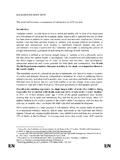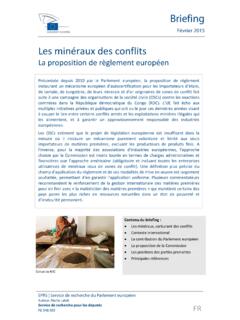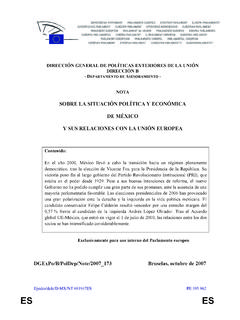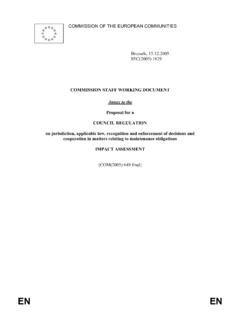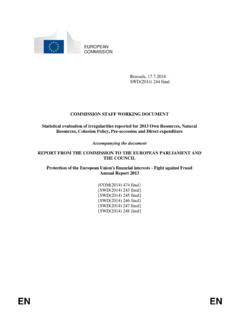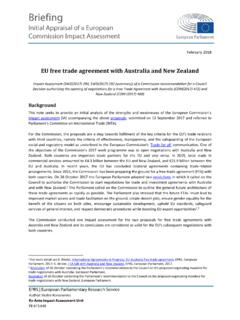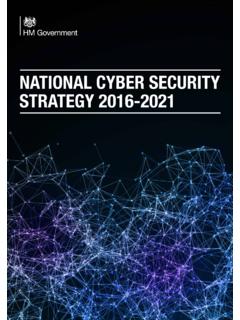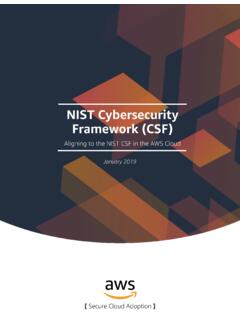Transcription of The NIS2 Directive
1 BRIEFING EU Legislation in Progress EPRS | European Parliamentary Research Service Author: Mar Negreiro Members' Research Service PE June 2022 EN The NIS2 Directive A high common level of cybersecurity in the EU OVERVIEW The Network and Information Security (NIS) Directive is the first piece of EU-wide legislation on cybersecurity , and its specific aim was to achieve a high common level of cybersecurity across the Member States. While it increased the Member States' cybersecurity capabilities, its implementation proved difficult, resulting in fragmentation at different levels across the internal market. To respond to the growing threats posed with digitalisation and the surge in cyber-attacks, the Commission has submitted a proposal to replace the NIS Directive and thereby strengthen the security requirements, address the security of supply chains, streamline reporting obligations, and introduce more stringent supervisory measures and stricter enforcement requirements, including harmonised sanctions across the EU.
2 The proposed expansion of the scope covered by NIS2, by effectively obliging more entities and sectors to take measures, would assist in increasing the level of cybersecurity in Europe in the longer term. Within the European Parliament, the file has been assigned to the Committee on Industry, Research and Energy. The committee adopted its report on 28 October 2021, as well as a mandate to enter into interinstitutional negotiations. For its part, the Council agreed its position on 3 December 2021. The co-legislators reached a provisional agreement on the text on 13 May 2022. The text now needs to be adopted formally by both institutions, with the Parliament due to vote on it in plenary in the coming months. Proposal for a Directive on measures for a high common level of cybersecurity across the Union Committee responsible: Rapporteur: Shadow rapporteurs: Industry, Research and Energy (ITRE) Bart Groothuis (Renew, the Netherlands) Eva Maydell (EPP, Bulgaria) Eva Kaili (S&D, Greece) Rasmus Andresen (Greens/EFA, Germany) Thierry Mariani (ID, France) Ev en To enovsk (ECR, Czechia) Marisa Matias (The Left, Portugal) COM(2020) 823 2020/0359(COD) Ordinary legislative procedure (COD) (Parliament and Council on equal footing formerly 'co-decision') Next steps expected: Final first-reading vote in plenary EPRS | European Parliamentary Research Service 2 Introduction Cyber-attacks, besides being among the fastest-growing form of crime worldwide, are also growing in scale, cost and sophistication.
3 In 2017, cybersecurity Ventures forecast that global ransomware damage costs would reach US$20 billion by 2021, 57 times more than the amount in 2015. It also predicted that companies would be suffering a ransomware attack every 11 seconds by 2021, up from every 40 seconds in 2016 . As a result, businesses have to invest more money to make cyberspace safer for themselves and their customers. Not only companies but also citizens and entire countries have been affected; the first known cyber-attack on a country was mounted on Estonia in April 2007, affecting the online services of banks, media outlets and government bodies for weeks. Since then, many other countries have suffered cyber-attacks, including on critical infrastructure, such as on electric power systems, hospitals or water plants.
4 According to a Eurobarometer survey, about three quarters (76 %) of respondents believe that they are facing an increasing risk of falling victim to cybercrime. In 2019, about 64 % of the US population experienced a data breach and 88 % of organisations worldwide experienced 'spear-phishing' attempts. Given the growing number and cost of cyber-attacks, spending on information security is also increasing worldwide. The global security market is currently worth around US$150 billion, a figure that many predict will rise to US$208 billion in 2023 and US$400 billion in 2026. Critical sectors, such as transport, energy, health and finance, have become increasingly dependent on digital technologies to run their core business. While growing digital connectivity brings enormous opportunities, it also exposes economies and societies to cyber-threats.
5 The number, complexity and scale of cybersecurity incidents are growing, as is their economic and social impact. The coronavirus pandemic has triggered an unforeseen acceleration in the digital transformation of societies around the world. Yet, it has also exacerbated existing problems, such as the digital divide, and contributed to a global rise in cybersecurity incidents. During this unprecedented situation, there has been an increase in malicious cyber-activity across Member States, as revealed by a recent Europol report. cybersecurity issues are becoming a day-to-day struggle for the EU. According to monitoring reports from the EU Agency for Network Information Security (ENISA), cybercrime is becoming increasingly monetised, particularly in the case of major cyber-attacks that use ransomware. Likewise, increased e-commerce and cashless payments bring heightened risks of cybercrime attacks and cybersecurity breaches.
6 With payments becoming increasingly cashless, online theft of money and also of personal data has been on the rise. An ENISA Threat Landscape 2021 report demonstrates that cyber-attacks are becoming more sophisticated, targeted, widespread and undetected, and concludes that societies face a long road ahead before they can ensure a more secure digital environment. According to Verizon, 86 % of breaches committed in 2019 were financially motivated and 10 % by espionage. About 45 % of breaches featured hacking, 17 % involved malware and 22 % involved phishing. This trend is expected to increase further, in parallel with technological developments such as the proliferation of devices linked to the Internet of Things (IoT). In an increasingly connected world, where billion IoT devices are expected to be in use by 2024, the growing challenges in the cybersecurity landscape have led the EU to reflect on how to enhance the protection of its citizens and companies against cyber-threats and attacks.
7 Existing situation The first step towards the creation and development of an EU cybersecurity ecosystem was the adoption of a cybersecurity strategy in 2013. The strategy identified the achievement of cyber-resilience and the development of industrial and technological resources for cybersecurity as its key objectives. The Directive on Security of Network and Information Systems across the EU (the NIS Directive ), which had to be transposed by Member States by 9 May 2018, represents the first piece of EU-wide legislation on cybersecurity . It provided for legal measures to boost the overall level of cybersecurity in the EU, with a focus on protecting critical infrastructure. Among other things, it The NIS2 Directive 3 established the NIS Cooperation Group, and the network of Computer Security Incident Response Teams (CSIRTs), to ensure both the exchange of information on cybersecurity and cooperation on specific cybersecurity incidents.
8 In view of the impending deadlines for its transposition into national legislation (by 9 May 2018) and the identification of operators of essential services (by 9 November 2018), the Commission adopted on 13 September 2017 a communication aimed at supporting Member States in their efforts to implement the Directive swiftly and coherently across the EU. It introduced an NIS toolkit providing information to Member States on the best practices related to implementing the Directive as well as clarifications on some of its provisions. By 2020, all Member States had communicated to the Commission that they had fully transposed the Directive into their national legislation. Other legislative initiatives linked to cybersecurity date back to 2017, when the Commission submitted a package of cybersecurity measures to further improve the resilience and incident-response capacities of public and private entities, competent authorities and the EU as a whole in the field of cybersecurity and critical infrastructure protection.
9 It also asked for a permanent and enhanced role for the EU cybersecurity agency and the creation of the first EU cybersecurity certification framework, which resulted in the cybersecurity Act. Since then, a new EU cybersecurity strategy for 2020-2025 has been adopted, proposing among many things the review of the NIS Directive , the adoption of a new critical entities resilience (CER) Directive , a network of security operations centres (SOCs) and new measures to strengthen the EU cyber-diplomacy toolbox. It is in line with the Commission's priorities to make Europe fit for the digital age and to build a future-ready economy that works for the people. The threat landscape has changed considerably since the NIS Directive was adopted in 2016 , and the scope of the Directive needs updating and expanding to meet current risks and future challenges, one such challenge being to ensure that 5G technology is secure.
10 In addition, its transposition and implementation has brought to light inherent flaws in certain provisions or approaches, such as the unclear delimitation of the scope of the Directive . Furthermore, since the onset of the coronavirus crisis, the EU economy has grown more dependent on network and information systems than ever before, and sectors and services are increasingly interconnected. The pandemic has more than confirmed the importance of preparing the EU for the digital decade as well as the need to continually improve cyber-resilience, particularly for those who operate essential services such as healthcare and energy. Funding for EU cybersecurity initiatives has increased in the 2021-2027 programming period through a mix of instruments such as the Digital Europe Programme, Horizon Europe, the European Defence Fund, and the EU Recovery and Resilience Facility.


